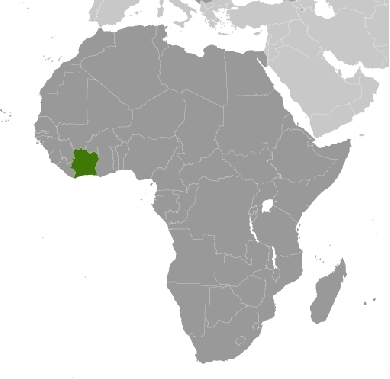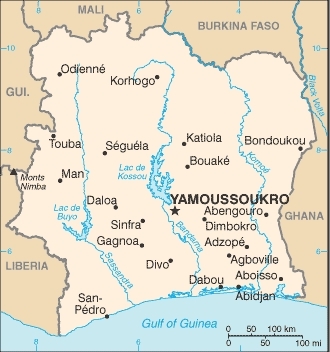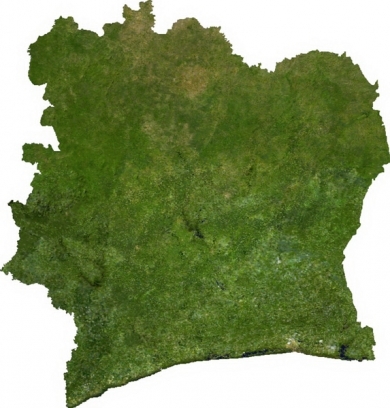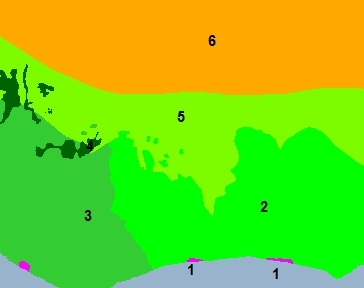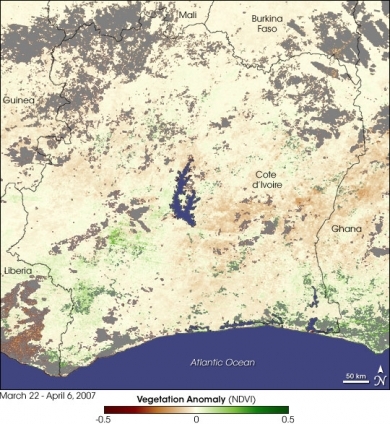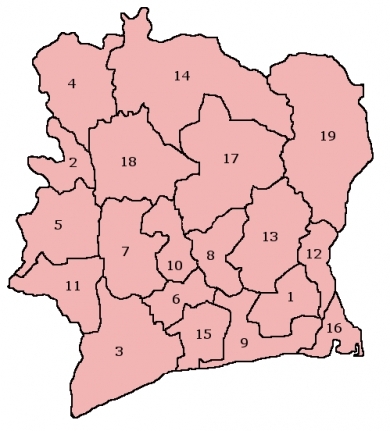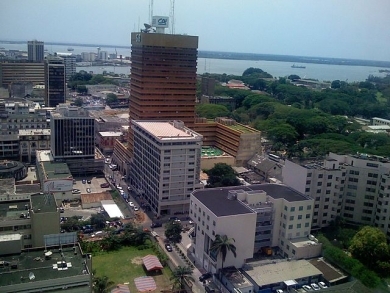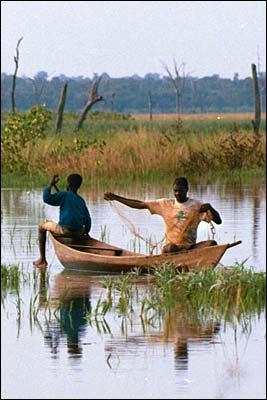Côte d’Ivoire
Contents
Côte d'Ivoire
Countries and Regions of the World Collection  Côte d'Ivoire (formerly "Ivory Coast") is a west African nation of twenty-two million people with its coast along the Gulf of Guinea in the North Atlantic Ocean, between Ghana and Liberia.
Côte d'Ivoire (formerly "Ivory Coast") is a west African nation of twenty-two million people with its coast along the Gulf of Guinea in the North Atlantic Ocean, between Ghana and Liberia.
Most of the inhabitants live along the sandy coastal region. Apart from the capital area, the forested interior is sparsely populated.
Côte d'Ivoire's major environmental issues include:
- deforestation (most of the country's forests - once the largest in West Africa - have been heavily logged); and,
- water pollution from sewage and industrial and agricultural effluents.
Close ties to France since independence in 1960, the development of cocoa production for export, and foreign investment made Cote d'Ivoire one of the most prosperous of the West African states, but did not protect it from political turmoil.
In December 1999, a military coup - the first ever in Cote d'Ivoire's history - overthrew the government. Junta leader Robert Guei blatantly rigged elections held in late 2000 and declared himself the winner. Popular protest forced him to step aside and brought Laurent Gbagbo into power. Ivorian dissidents and disaffected members of the military launched a failed coup attempt in September 2002. Rebel forces claimed the northern half of the country, and in January 2003 were granted ministerial positions in a unity government under the auspices of the Linas-Marcoussis Peace Accord. President Gbagbo and rebel forces resumed implementation of the peace accord in December 2003 after a three-month stalemate, but issues that sparked the civil war, such as land reform and grounds for citizenship, remained unresolved.
In March 2007 President Gbagbo and former New Force rebel leader Guillaume Soro signed the Ouagadougou Political Agreement. As a result of the agreement, Soro joined Gbagbo's government as Prime Minister and the two agreed to reunite the country by dismantling the zone of confidence separating North from South, integrate rebel forces into the national armed forces, and hold elections. Disarmament, demobilization, and reintegration of rebel forces have been problematic as rebels seek to enter the armed forces. Citizen identification and voter registration pose election difficulties, and balloting planned for November 2009 was postponed to 2010.
On 28 November 2010, Alassane Dramane Ouattara won the presidential election, defeating then President Laurent Gbagbo. Gbagbo refused to hand over power, resulting in a 6-month stand-off. In April 2011, after widespread fighting, Gbagbo was formally forced from office by Ouattara supporters with the support of UN and French forces. Several thousand UN troops and several hundred French remain in Cote d'Ivoire to support the transition process.
Geography
Location: Western Africa, bordering the North Atlantic Ocean, between Ghana and Liberia
Geographic Coordinates: 8 00 N, 5 00 W
Area: 322,460 km2 (318,000 km2 land and 4,460 km2 water)
arable land: 10.23%
permanent crops: 11.16%
other: 78.61% (2005)
Land Boundaries: 3,110 km. Border countries: Burkina Faso 584 km, Ghana 668 km, Guinea 610 km, Liberia 716 km, Mali 532 km
Coastline: 515 km
Maritime Claims:
territorial sea: 12 nm
exclusive economic zone: 200 nm
continental shelf: 200 nm
Natural Hazards: coast has heavy surf and no natural harbors; during the rainy season torrential flooding is possible
Terrain: Mostly flat to undulating plains; mountains in northwest. Its lowest point is the Gulf of Guinea (0 metres) and its highest point is Mont Nimba (1,752 metres)
Climate: Tropical along coast, semiarid in far north; three seasons - warm and dry (November to March), hot and dry (March to May), hot and wet (June to October)
|
Source: The Map Library |
Source: Wikimedia Commons |
Ecology and Biodiversity
|
1. Guinean mangroves 3. Western Guinean lowland forests 5. Guinean forest-savanna mosaic See also: |
Ecoregions of Côte d'Ivoire. Source: World Wildlife Fund |
National Parks:
- Assagny National Park
- Banco National Park
- Comoé National Park
- Îles Ehotilés National Park
- Marahoué National Park
- Mont Nimba National Park
- Mont Péko National Park
- Mont Sângbé National Park
- Taï National Park
People and Society
Population: 21,952,093 (July 2012 est.)
Cote d'Ivoire has more than 60 ethnic groups, usually classified into five principal divisions: Akan (east and center, including Lagoon peoples of the southeast), Krou (southwest), Southern Mande (west), Northern Mande (northwest), Senoufo/Lobi (north center and northeast). The Baoules, in the Akan division, probably comprise the single largest subgroup with 15%-20% of the population. They are based in the central region around Bouake and Yamoussoukro. The Betes in the Krou division, the Senoufos in the north, and the Malinkes in the northwest and the cities are the next largest groups, with 10%-15% each of the national population. Most of the principal divisions have a significant presence in neighboring countries.
Of the more than 5 million non-Ivoirian Africans living in Cote d'Ivoire, one-third to one-half are from Burkina Faso; the rest are from Ghana, Guinea, Mali, Nigeria, Benin, Senegal, Liberia, and Mauritania. The non-African expatriate community includes roughly 10,000 French and possibly 60,000 Lebanese. In November 2004, thousands of expatriates, African and non-African, fled from violence in Cote d'Ivoire. Subsequently, many expatriates slowly returned.
Ethnic groups: Akan 42.1%, Voltaiques or Gur 17.6%, Northern Mandes 16.5%, Krous 11%, Southern Mandes 10%, other 2.8% (includes 130,000 Lebanese and 14,000 French) (1998)
|
Drought settled over West Africa’s Ivory Coast region when wet season rains came late in 2007. Instead of beginning in February, the rainy season didn’t start until March, and steady rains didn’t start until late March, said the Famine Early Warning System Network. Though the rain had started to alleviate the drought, vegetation was still depressed in parts of Côte d’Ivoire (Ivory Coast) between March 22 and April 6, 2007, when the Moderate Resolution Imaging Spectroradiometer (MODIS) on NASA’s Terra satellite captured the data used to make this image. The image shows current vegetation conditions compared to average conditions recorded since 2000. Areas where plants are growing more slowly or more sparsely than average are brown, while areas where vegetation is denser than average are green. The brown tint that dominates the image indicates that plants through most of the country are more sparse than normal. Among the crops affected by the lack of rain was West Africa’s cocoa crop. About 70 percent of the world’s cocoa comes from West Africa, and Côte d’Ivoire is a top grower, said Reuters. Cocoa prices climbed as the crop fell short. Farmers called the drought the worst in living memory, Reuters said. The delay in rainfall also led to water shortages in parts of Côte d’Ivoire, according to the United Nations Office for the Coordination of Humanitarian Affairs. Source: NASA. NASA image created by Jesse Allen, Earth Observatory, using data provided by Inbal Reshef as part of the Global Agricultural Monitoring Project between NASA, the USDA Foreign Agricultural Service (FAS), and the University of Maryland. |
Age Structure:
0-14 years: 39.8% (male 4,312,133/female 4,240,500)
15-64 years: 57.2% (male 6,262,802/female 6,039,458)
65 years and over: 3% (male 320,396/female 328,873) (2011 est.)
Population Growth Rate: 2.044% (2012 est.)
Birthrate: 30.4 births/1,000 population (2012 est.)
Death Rate: 9.96 deaths/1,000 population (July 2012 est.)
Net Migration Rate: 0 migrant(s)/1,000 population NA (2012 est.)
Life Expectancy at Birth: 57.25 years
male: 56.21 years
female: 58.33 years (2012 est.)
Total Fertility Rate: 3.82 children born/woman (2012 est.)
Languages: French (official), 60 native dialects with Dioula the most widely spoken
Literacy (age 15 and over can read and write) 48.7% (male: 60.8% - female: 38.6% Est.)
Urbanization: 51% of total population (2010) growing at an annual rate of change of 3.7% (2010-15 est.)
History
The early history of Cote d'Ivoire is virtually unknown, although it is thought that a Neolithic culture existed. France made its initial contact with Cote d'Ivoire in 1637, when missionaries landed at Assinie near the Gold Coast (now Ghana) border. Early contacts were limited to a few missionaries because of the inhospitable coastline and settlers' fear of the inhabitants.
In the 18th century, the country was invaded from present-day Ghana by two related Akan groups--the Agni, who occupied the southeast, and the Baoule, who settled in the central section. In 1843-44, Admiral Bouet-Williaumez signed treaties with the kings of the Grand Bassam and Assinie regions, placing their territories under a French protectorate. French explorers, missionaries, trading companies, and soldiers gradually extended the area under French control inland from the lagoon region. However, complete pacification was not accomplished until 1915.
'French Period
Cote d'Ivoire officially became a French colony in 1893. Captain Binger, who had explored the Gold Coast frontier, was named the first governor. He negotiated boundary treaties with Liberia and the United Kingdom (for the Gold Coast) and later started the campaign against Almany Samory, a Malinke chief, who fought against the French until 1898.
From 1904 to 1958, Cote d'Ivoire was a constituent unit of the Federation of French West Africa. It was a colony and an overseas territory under the French Third Republic. Until the period following World War II, governmental affairs in French West Africa were administered from Paris. France's policy in West Africa was reflected mainly in its philosophy of "association," meaning that all Africans in Cote d'Ivoire were officially French "subjects" without rights to citizenship or representation in Africa or France.
During World War II, France's Vichy regime remained in control until 1943, when members of Gen. Charles de Gaulle's provisional government assumed control of all French West Africa. The Brazzaville Conference in 1944, the first Constituent Assembly of the French Fourth Republic in 1946, and France's gratitude for African loyalty during World War II led to far-reaching governmental reforms in 1946. French citizenship was granted to all African "subjects," the right to organize politically was recognized, and various forms of forced labor were abolished.
A turning point in relations with France was reached with the 1956 Overseas Reform Act (Loi Cadre), which transferred a number of powers from Paris to elected territorial governments in French West Africa and also removed remaining voting inequalities.
Independence
In December 1958, Cote d'Ivoire became an autonomous republic within the French community as a result of a referendum that brought community status to all members of the old Federation of French West Africa (except Guinea, which had voted against association). Cote d'Ivoire became independent on August 7, 1960 and Felix Houphouet-Boigny assumed the presidency.
Cote d'Ivoire's contemporary political history is closely associated with Houphouet-Boigny's 33-year presidency. He was the leader of the main political party until the 1990s, the Parti Democratique de la Cote d'Ivoire (PDCI), and one of the founders of the Rassemblement Democratique Africain (RDA), the leading pre-independence inter-territorial political party in French West African territories (except Mauritania).
Houphouet-Boigny first came to political prominence in 1944 when he founded the Syndicat Agricole Africain, an organization that won improved conditions for African farmers and formed a nucleus for the PDCI. After World War II, he was elected by a narrow margin to the first Constituent Assembly, representing Cote d'Ivoire in the French National Assembly from 1946 to 1959. He devoted much of his effort to inter-territorial political organization and further improvement of labor conditions. In May 1959, he reinforced his position as a dominant figure in West Africa by leading Cote d'Ivoire, Niger, Upper Volta (Burkina), and Dahomey (Benin) into the Council of the Entente, a regional organization promoting economic development. He maintained that the road to African solidarity was through step-by-step economic and political cooperation, and his key principle was non-intervention in internal affairs of other African states.
After serving 13 years in the French National Assembly, including almost 3 years as a minister in the French Government, he became Cote d'Ivoire's first Prime Minister in April 1959. He was elected the first President of Cote d’Ivoire in 1960 and served for 33 years.
1999 - Coup and Aftermath
In a region where many political systems are unstable, Cote d'Ivoire showed remarkable political stability from its independence from France in 1960 until late 1999. Under Felix Houphouet-Boigny, President from independence until his death on December 7, 1993, Cote d'Ivoire maintained a close political allegiance to the West while many countries in the region were undergoing repeated military coups, experimenting with Marxism, and developing ties with the Soviet Union and China. His successor, President Henri Konan Bedie, served from 1993 to 1999 and was familiar with the U.S., having served as Cote d'Ivoire's first ambassador to the U.S. Falling world market prices for Cote d'Ivoire's primary exports of cocoa and coffee put pressure on the economy and the Bedie presidency. Government corruption and mismanagement led to steep reductions in foreign aid in 1998 and 1999, and eventually to the country's first coup on December 24, 1999.
Following the bloodless coup, General Robert Guei formed a government of national unity and promised open elections. A new constitution was drafted and ratified by the population in the summer of 2000. It retained clauses that underscored national divisions between north and south and Christians and Muslims, and established stricter eligibility requirements for contesting political office, including that both parents of anyone wishing to run for president must be born in Cote d’Ivoire.
Elections were scheduled for fall 2000, but when the general's handpicked Supreme Court disqualified all of the candidates from the two major parties--the PDCI and Rassemblement des Republicaines (RDR)--Western election support and monitors were withdrawn. The RDR called for a boycott, setting the stage for low election turnout in a race between Guei and Front Populaire Ivoirien (FPI) candidate Laurent Gbagbo. When early polling results showed Gbagbo in the lead, Guei stopped the process--claiming polling fraud--disbanded the election commission, and declared himself the winner. Within hours Gbagbo supporters took to the streets of Abidjan. A bloody fight followed as crowds attacked the guards protecting the presidential palace. Many gendarmes and soldiers joined the fight against the junta government, forcing Guei to flee. Having gained the most votes, Gbagbo was declared President. The RDR then took to the streets, calling for new elections because the Supreme Court had declared their presidential candidate and all the candidates of the PDCI ineligible. More violence erupted as forces loyal to the new government joined the FPI youth to attack RDR demonstrators. Hundreds were killed in the few days that followed before RDR party leader Alassane Ouattara called for peace and recognized the Gbagbo presidency.
2001 - Attempted Coup
Although there was another coup attempt on January 7, 2001, local municipal elections were conducted in the spring without violence and with the full participation of all political parties. The RDR, which had boycotted the presidential and legislative elections, won the most local seats, followed by the PDCI and FPI. Some economic aid from the European Union began to return by the summer of 2001, and the International Monetary Fund (IMF) re-engaged the government. Questions surrounding severe human rights abuses by the government during the 2000 presidential and legislative elections remained unresolved (e.g., a mass grave at Yopougon), but day-to-day life began to return to normal. In August 2002, President Gbagbo formed a de facto government of national unity that included the RDR party.
2002 - 'The 'Country Divides
On September 19, 2002, exiled military personnel and co-conspirators in Abidjan simultaneously attacked government ministers and government and military/security facilities in Abidjan, Bouake, and Korhogo. In Abidjan, government forces managed to stop the coup attempt within hours, but the attacks resulted in the deaths of Minister of Interior Emile Boga Doudou and several high-ranking military officers. General Guei was killed under still-unclear circumstances. Almost immediately after the coup attempt, the government launched an aggressive security operation, in which shantytowns--occupied by thousands of immigrants and Ivoirians--were searched for weapons and rebels. Government security forces burned down or demolished a number of these shantytowns, which displaced over 12,000 people.
The failed coup attempt quickly evolved into a rebellion, split the country in two, and escalated into the country's worst crisis since independence in 1960. The rebel group, calling itself the "Patriotic Movement of Cote d'Ivoire" (MPCI), retained control in Bouake and Korhogo, and within 2 weeks moved to take the remainder of the northern half of the country. In mid-October 2002, government and MPCI representatives signed a ceasefire and French military forces already present in the country agreed to monitor the ceasefire line. In late November 2002, the western part of the country became a new military front with the emergence of two new rebel groups--the Ivoirian Popular Movement for the Great West (MPIGO) and the Movement for Justice and Peace (MJP). MPIGO and MJP were allied with the MPCI, and the three groups subsequently called themselves the "New Forces." In January 2003, the Economic Community of West African States (ECOWAS) placed approximately 1,500 peacekeeping troops from five countries--Senegal (commander), Ghana, Benin, Togo, and Niger--on the ground beside the 4,000 French peacekeepers. The troops maintained the east-west ceasefire line, known as the Zone of Confidence, dividing the country.
2003-2006 - 'Reunification Attempts
In late January 2003, the country's major political parties and the New Forces signed the French-brokered Linas-Marcoussis Accord (LMA), agreeing to a power-sharing national reconciliation government to include rebel New Forces representatives. The parties agreed to work together on modifying national identity, eligibility for citizenship, and land tenure laws that many observers considered among the root causes of the conflict. The LMA also stipulated a UN Monitoring Committee to report on implementation of the accord. The same month, President Gbagbo appointed Seydou Diarra as the consensus Prime Minister. In March 2003, Prime Minister Diarra formed a government of national reconciliation of 41 ministers. On July 4, 2003, the government and New Forces militaries signed an "End of the War" declaration that recognized President Gbagbo's authority and vowed to work for the implementation of the LMA and a program of demobilization, disarmament, and reintegration (DDR). On September 13, 2003, 6 months after the formation of the reconciliation government, President Gbagbo named politically neutral Defense and Security Ministers, after consulting with the political parties and New Forces.
2004 saw serious challenges to the Linas-Marcoussis Accord. Violent flare-ups and political deadlock in the spring and summer led to the Accra III talks in Ghana. Signed on July 30, 2004, the Accra III Agreement reaffirmed the goals of the LMA with specific deadlines and benchmarks for progress. Unfortunately, those deadlines--late September for legislative reform and October 15 for rebel disarmament--were not met by the parties. The ensuing political and military deadlock was not broken until November 4, when government forces initiated a bombing campaign of rebel targets in the north. On November 6, a government aircraft bombed a French military installation in Bouake, killing nine French soldiers and one American civilian. Claiming that the attack was deliberate (the Ivoirian Government claimed it was a mistake), French forces retaliated by destroying most of the small Ivoirian air force. Mayhem ensued for several days as anti-French mobs rioted in Abidjan and violence flared elsewhere. On November 15, 2004 the United Nations Security Council issued an immediate arms embargo on Cote d'Ivoire and gave leaders 1 month to get the peace process back on track or face a travel ban and an asset freeze. In April 2005, South African President Thabo Mbeki invited the leaders to South Africa for an African Union-sponsored mediation effort. The result was the Pretoria Agreement, signed April 6, 2005. The Pretoria Agreement formally ended the country's state of war, and addressed issues such as disarmament, demobilization, and reintegration, the return of New Forces Ministers to government, and the reorganization of the Independent Electoral Commission. A follow-up agreement in June 2005 laid out another framework for disarmament, elections, and the adoption of legislation required under the Linas-Marcoussis Accord.
In September 2005, the government postponed presidential elections scheduled for October 30, 2005. In October 2005, the UN Security Council, via UN Security Council Resolution (UNSCR) 1633, endorsed an African Union decision to extend the Linas-Marcoussis peace process for an additional 12 months. As called for under 1633, a new Prime Minister, Charles Konan Banny, was selected by the international community and given broad powers designed to reunify the country. Banny selected a new cabinet in December 2005 in collaboration with the opposition, the President, and the New Forces. In January 2006, militias loyal to President Gbagbo mounted violent protests against statements by the UN Operation in Cote d'Ivoire (UNOCI) regarding the role of the National Assembly during the ongoing transition period. These protests threatened the independence of the Banny government and the ability of UNOCI and the International Working Group (created by the UN Security Council to oversee the peace process) to help the country achieve a stable, lasting reconciliation.
Initial steps toward disarmament and elections began in May 2006. The government began a pilot identification program for citizens and foreign residents lacking birth and nationality certificates. Government and rebel New Forces military formations began pre-groupment activities as a prelude to actual disarmament. Neither initiative was completed, and elections did not take place on October 31, 2006, as mandated by UN Security Council Resolution 1633. In November 2006, the UN Security Council issued a new resolution, 1721, which extended Prime Minister Banny's mandate for an additional 12 months. Prime Minister Banny was effectively blocked, however, from exercising control over the government as envisioned by the international community. President Gbagbo closed out 2006 with a speech to the nation in which he called for direct talks with the New Forces and the elimination of the Zone of Confidence.
Ouagadougou Political Agreement
On March 4, 2007, after weeks of closed-door negotiations led by Burkinabe President Compaore in Ouagadougou, Burkina Faso, President Gbagbo and New Forces leader Guillaume Soro announced they had agreed to a peace agreement aimed at reunifying the country and holding new elections. The Ouagadougou Agreement foresaw a new transitional government and the re-launch of the stalled voter registration and identification process to enable elections to be held within 10 months. It also called for the near-immediate elimination of the Zone of Confidence; the disarmament, demobilization, and reintegration of former combatants; and for rebel and government forces to form a joint integrated Command Center that would implement the measures for the restructuring of the Defense and Security Forces.
At the end of March, Soro was named Prime Minister, and several days later, a new cabinet--consisting of most of the ministers from the previous cabinet--was named. Subsequently, UNOCI withdrew from within the Zone of Confidence, although it was still positioned on both sides, and six mixed brigades of New Forces, national Gendarmerie soldiers, and impartial forces were established. The Zone of Confidence was dismantled in September 2007, but both the mixed brigades and impartial forces continued to carry out patrols throughout the ex-Zone of Confidence.
On June 29, 2007, an attack against Prime Minister Soro’s aircraft occurred at the Bouake Airport, killing several persons in his entourage, but he escaped unharmed. Government ministries (particularly Health, Education, Finance, and Interior) and officials returned to their posts in the northern part of the country and the disarmament, demobilizaton, and reintegration (DDR) of former combatants began on a limited scale. As part of the DDR process, in January 2008, the Defense and Security Forces completed regroupment. In late 2009, cantonment of some New Forces had begun in Bouake, with preparations continuing in other areas of the north.
In September 2007, the first step in the identification of voters commenced when a series of mobile courts began issuing birth certificates to those who never had them. In April 2008, the government announced elections would be held on November 30, 2008. In early November 2008, those elections were postponed; a new date of November 29, 2009 was later set. In late December 2008, the parties to the Ouagadougou Political Agreement (OPA) signed the fourth supplementary agreement to the OPA. Under the terms of this agreement, disarmament, demobilization, and reintegration was to be completed 2 months before presidential elections. Citizen identification and voter registration continued to pose operational challenges. Identification and registration was launched nationwide in early December 2008 and proceeded fairly smoothly, although with some delays. On November 11, 2009, the Independent Electoral Commission (CEI) announced that the elections scheduled for November 29 would again be postponed to allow for the completion of the registration process. No new election date was set at the time of postponement. A provisional electoral list was completed on November 10, 2009, to be posted at all election sites throughout the country. A 30-day dispute period was to begin when the lists had been physically posted, allowing anyone to challenge the names on the provisional list.
On February 12, 2010, President Gbagbo announced the dissolution of the government and the CEI, amid claims of fraud during the voter registration process. The decision, as well as frustration regarding several localized cases of mismanagement of the voter list, sparked riots in several cities outside of Abidjan that resulted in at least 12 deaths. Following several weeks of negotiations, a new government was announced and a new head of the CEI was appointed.
2010 Presidential Elections
After several years of delays, the first round of presidential elections was held on October 31, 2010. The election was hailed by all candidates and observers as peaceful and fair, with nearly 80% voter turnout and no significant irregularities reported. The November 28 runoff between Alassane Ouattara and incumbent President Gbagbo was again characterized by high voter turnout and largely peaceful participation by the Ivoirian people, and Ouattara was declared the winner by the CEI. Credible and accredited observers assessed both rounds as fair and free of irregularities that would have affected the results. Gbagbo refused to cede power, and a period of fighting ensued. Ouattara was formally inaugurated in May 2011.
Government
Cote d'Ivoire's constitution of the Second Republic (2000) provides for a strong presidency within the framework of a separation of powers. The executive is personified in the president, elected for a 5-year term. The president is the head of state and commander in chief of the armed forces, may negotiate and ratify certain treaties, and may submit a bill to a national referendum or to the National Assembly. According to the constitution, the president of the National Assembly assumes the presidency for 45-90 days in the event of a vacancy and organizes new elections in which the winner completes the remainder of the deceased president's term. The president selects the prime minister, who is the head of government. The cabinet is selected by and is responsible to the prime minister.
The unicameral National Assembly is composed of 225 members elected by direct universal suffrage for a 5-year term, normally concurrently with the president. It passes on legislation typically introduced by the president, although it also can introduce legislation.
Government Type: republic; multiparty presidential regime established 1960; note: the government is currently operating under a power-sharing agreement mandated by international mediators
Capital: Yamoussoukro (population: 808,000 est. 2009)
Other Major City: Abidjan (seat of government) (population 4.009 million est. 2009)
|
Administrative Divisions: For administrative purposes, Cote d'Ivoire is divided into 19 regions and 90 departments. Each region and department is headed by a prefect appointed by the central government. In 2002, the country held its first departmental elections to select departmental councils to oversee local infrastructure development and maintenance as well as economic and social development plans and projects. There are 196 communes, each headed by an elected mayor, plus the city of Abidjan with 10 mayors. The 9 regions are:
|
Source: Wikimedia Commons |
Independence Date: 7 August 1960 (from France)
Legal System: based on French civil law system and customary law. The judicial system culminates in the Supreme Court. The High Court of Justice is competent to try government officials for major offenses. There is also an independent Constitutional Council which has seven members appointed by the president that is responsible for, inter alia, the determination of candidate eligibility in presidential and legislative elections, the announcement of final election results, the conduct of referendums, and the constitutionality of legislation. Côte d'Ivoire accepts compulsory International Court of Justice (ICJ) jurisdiction, with reservations. It accepts International Criminal (ICCt) jurisdiction under Article 12(3)of the Rome Statute.
Suffrage: 18 years of age; universal
International Environmental Agreements
Côte d'Ivoire is party to international agreements on: Biodiversity, Climate Change, Climate Change-Kyoto Protocol, Desertification, Endangered Species, Hazardous Wastes, Law of the Sea, Marine Dumping, Ozone Layer Protection, Ship Pollution, Tropical Timber 83, Tropical Timber 94, Wetlands, and Whaling.
Water
Total Renewable Water Resources: 81 cu km (2001)
Freshwater Withdrawal: Total: 0.93 cu km/yr (24% domestic, 12% industrial, 65% agriculture). Per capita: 51 cu m/yr (2000)
Access to improve drinking water sources: 80% of population (2008)
Access to improved sanitation facilities: 23% of population (2008)
Agriculture
Agricultural Products: coffee, cocoa beans, bananas, palm kernels, corn, rice, manioc (tapioca), sweet potatoes, sugar, cotton, rubber; timber
Irrigated Lands: 730 sq km (2003)
Resources
Natural Resources: petroleum, natural gas, diamonds, manganese, iron ore, cobalt, bauxite, copper, gold, nickel, tantalum, silica sand, clay, cocoa beans, coffee, palm oil, hydropower
Energy
| Production | Consumption | Exports | Imports | Reserves | |
|
Electricity |
5.548 billion kWh (2008 est.) |
3.584 billion kWh (2008 est.) |
599 million kWh (2008 est.) |
599 million kWh (2008 est.) |
|
|
Oil |
44,880 bbl/day (2010 est.) |
25,000 bbl/day (2010 est.) |
70,800 bbl/day (2009 est.) |
85,190 bbl/day (2009 est.) |
100 million bbl (1 January 2011 est.) |
|
Natural Gas |
1.6 billion cu m (2009 est.) |
1.6 billion cu m (2009 est.) |
0 cu m (2009 est.) |
0 cu m (2009) |
28.32 billion cu m (1 January 2011 est.) |
|
Source: CIA Factbook | |||||
Conflict
International Dispute: Despite the presence of over 9,000 UN forces (UNOCI) in Cote d'Ivoire since 2004, ethnic conflict still leaves displaced hundreds of thousands of Ivorians in and out of the country as well as driven out migrants from neighboring states who worked in Ivorian cocoa plantations.
The March 2007 peace deal between Ivorian rebels and the government brought significant numbers of rebels out of hiding in neighboring states
| Abidjan. Source: Wikimedia Commons. |
|
A fishermen throws his net into the Bandama River to catch fish, which he will sell the next day. The river flows from Lake Kossou to the Gulf of Guinea. Source: Lori Duff/U.S. Peace Corps |
Economy
The Ivoirian economy is largely market-based and depends heavily on the agricultural sector. Between 60% and 70% of the Ivoirian people are engaged in some form of agricultural activity.
Cote d'Ivoire is the world's largest producer and exporter of cocoa beans and a significant producer and exporter of coffee and palm oil. Consequently, the economy is highly sensitive to fluctuations in international prices for these products, and, to a lesser extent, in climatic conditions. Cocoa, oil, and coffee are the country's top export revenue earners, but the country is also producing gold.
The economy performed poorly in the 1980s and early 1990s, and high population growth coupled with economic decline resulted in a steady fall in living standards. A majority of the population remains dependent on smallholder cash crop production. Principal exports are petroleum, cocoa, coffee, pineapples, tuna, rubber, and tropical woods. Principal U.S. exports to Cote d’Ivoire are rice and wheat, plastic materials and resins, kraft paper, agricultural chemicals, telecommunications, and oil and gas equipment. Principal U.S. imports from Cote d’Ivoire are cocoa and cocoa products, petroleum, rubber, and coffee.
Since the end of the civil war in 2003, political turmoil has continued to damage the economy, resulting in the loss of foreign investment and slow economic growth. GDP grew by more than 2% in 2008 and around 4% per year in 2009-10. Per capita income has declined by 15% since 1999, but registered a slight improvement in 2009-10.
Foreign Direct Investment Statistics
Direct foreign investment plays a key role in the Ivoirian economy, accounting for between 40% and 45% of total capital in Ivoirian firms. France is overwhelmingly the most important foreign investor. In recent years, French investment has accounted for about one-quarter of the total capital in Ivoirian enterprises, and between 55% and 60% of the total stock of foreign investment capital.
Infrastructure
By developing-country standards, Cote d'Ivoire has good infrastructure. There is a network of more than 8,000 miles of paved roads; good telecommunications services, including a public data communications network, cellular phones, and Internet access. There are two active ports. Abidjan's is the most modern in West Africa and the largest between Casablanca and Cape Town. A smaller port is located in San Pedro. There is regular air service between countries within the region and to and from Europe. Modern real estate developments exist for commercial, industrial, retail, and residential use.
A decade of political and economic problems have delayed Cote d'Ivoire's planned public investment program. The government's public investment plan accords priority to investment in human capital, but it also will provide for significant spending on economic infrastructure needed to sustain growth. Continued infrastructure development has been brought into question because of private sector uncertainty. In the environment of government disengagement from production activities and in the wake of privatizations, anticipated investments in the petroleum, electricity, water, and telecommunications sectors, and in part in the transportation sector, will be financed without direct government intervention.
Major Trends and Outlooks
Since the colonial period, Cote d'Ivoire's economy has been based on the production and export of tropical products. Agriculture, forestry, and fisheries account for a substantial part of GDP and of exports. Cote d'Ivoire produces 40% of the world's cocoa crop and is a major exporter of bananas, coffee, cotton, palm oil, pineapples, rubber, tropical wood products, and tuna. The 1994 devaluation of the CFA franc and accompanying structural adjustment measures increased the international competitiveness of the agricultural, light industrial, and service sectors. However, reliance on commodity exports exposes the economy to the ups and downs of international price swings. To reduce the economic exposure to price variability, the government encourages export diversification and intermediate processing of cocoa beans. In recent years, petroleum exports have risen significantly, and petroleum is now the country's largest foreign exchange earner.
The 1994 devaluation of the CFA franc helped return Cote d'Ivoire to rapid economic growth until the slowdown evident by 1999. Increased aid flows, rigorous macroeconomic policies, and high international commodity prices, along with devaluation, yielded 6%-7% annual GDP growth rates from 1994-98. Cote d'Ivoire also benefited from Paris Club debt rescheduling in 1994, a London Club agreement in 1996, and the 1997 G-7 decision to include Cote d'Ivoire in the IMF-World Bank debt forgiveness initiative for heavily indebted poor countries.
In the past several years, economic decline has resulted in declining living standards. Falling commodity prices along with government corruption and fiscal mismanagement brought the economy to its knees by the end of 1999. At that point, the coup d'etat and the subsequent institution of the military junta government caused the loss of foreign assistance. Private foreign investment declined precipitously. Government internal and external debt ballooned. As a result, the Ivoirian economy contracted 2.3% in 2000. The government signed a Staff Monitoring Program with the IMF in July 2001, but plans for a subsequent Poverty Reduction and Growth Facility were disrupted by the onset of the crisis in September 2002.
The signs of economic and business recovery were encouraging in mid-year 2002, but the political and social crisis that began in September 2002 undermined all the efforts to resume cooperation with international donors. Economic growth has been negative or low each year since the outbreak of the 2002 armed rebellion, with a cutoff of most external assistance (except humanitarian aid), mounting domestic and foreign arrears, and a drastic slowdown in foreign and domestic investment. GDP growth reached 1.7% in 2007 and 2.3% in 2008, buoyed largely by growing oil and gas revenues.
The World Bank announced in April 2008 that Cote d'Ivoire had paid fully its arrears, paving the way for new assistance. In March 2009, Cote d’Ivoire reached the decision point for debt relief under the Enhanced Heavily Indebted Poor Countries (HIPC) Initiative. The IMF approved a U.S. $565.7 million Poverty Reduction and Growth Facility. The IMF Board noted Cote d’Ivoire’s satisfactory performance under its two Emergency Post-Conflict Assistance programs and called for continued reforms toward HIPC completion point.
Power cuts caused by a turbine failure in early 2010 slowed economic activity.
Cote d'Ivoire in 2010 signed agreements to restructure its Paris Club bilateral, other bilateral, and London Club debt.
In late 2011, Cote D'Ivoire's economy was recovering from a severe downturn of the first quarter of the year that was caused by widespread post-election fighting.
Political and economic stability is critical if Cote d'Ivoire is to realize strong economic growth and its potential in the region. GDP growth for 2010 was 2.6%.
GDP (Purchasing Power Parity): $35.6 billion (2011 est.)
GDP (Official Exchange Rate): $23.8 billion (2011 est.)
GDP-per capita (PPP): $1,600 (2011 est.)
GDP-composition by sector:
agriculture: 29.2%
industry: 20.9%
services: 49.8% (2011 est.)
Population Below Poverty Line: 42% (2006 est.)
Industries: foodstuffs, beverages; wood products, oil refining, truck and bus assembly, textiles, fertilizer, building materials, electricity, ship construction and repair
Exports: cocoa, coffee, timber, petroleum, cotton, bananas, pineapples, palm oil, fish
Imports: fuel, capital equipment, foodstuffs
Currency: Communaute Financiere Africaine franc (XOF)
Ports and Terminals: Abidjan, Espoir, San-Pedro

